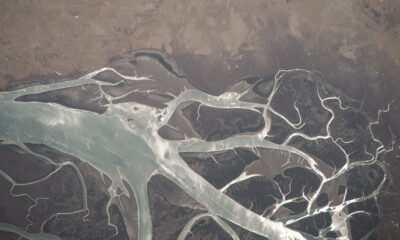Creation Corner
Moon water in bulk

Moon water is not just on the surface of the moon. It lies beneath, and in proportions close to those in Earth’s mantle.
Moon water discovered
Scientists at Brown University announced their find two days ago. They looked at rocks and soil that the Apollo teams had brought back. Specifically they looked at “melt inclusions,” balls of melted rock trapped within crystals of obsidian. (Obsidian is glass that forms anywhere that rock melts. This can happen at an active volcano or anywhere that molten rock flows freely.) The Brown team found 100 times as much water in these melt inclusions than anyone expected.
This confirms what other scientists have suspected for about three years. In fact, the moon’s mantle seems to have as much water as does the upper mantle on Earth.
Where did moon water come from?
Now the story gets confusing, because no one knows for certain where this water came from. But one classical theory of how the moon came to exist is in trouble. According to that theory, a giant asteroid, about as big and as heavy as Mars, hit the earth and broke the moon off. Supporters of that theory always said that the moon seemed very dry compared to earth, and their theory would predict that. Now they’re not so sure.
In fact, the water probably did not exist as liquid water when the moon came to be. The mantles of the earth and the moon contain hydrates, plus other minerals that have hydroxyl (one part hydrogen, one part oxygen) groups on them. Anything that melts those minerals will set the water free. The water is lighter than the other minerals and will rise to the top. That’s why people find it in obsidian or other igneous rocks (rocks formed in fire).
[amazon_carousel widget_type=”ASINList” width=”500″ height=”250″ title=”” market_place=”US” shuffle_products=”True” show_border=”False” asin=”1878026097, 0890515077, 0310234697, 0875523382, 0890511586, B002RBHDFK, 0949906689, 0890513600, 089051416X, 0890515050″ /]
What else does all this moon water mean?
According to Science Daily, the Brown team wonders whether some of the moon water at the lunar poles came from the same source. Some of it might have, but not much. Most moon water on the ground fell to the moon in comets immediately after the Global Flood.
The bigger question is how did so much water float almost to the surface, so that the Apollo astronauts could find it. Something had to make the ground very hot. But no astronomer has ever found a true volcano cone on the moon. (Mars and Io, moon of Jupiter, are the only two bodies, other than earth, that have true volcanoes.) The heat did not come from inside, but from outside—from above. Seven very large rocks hit the moon within a short time, and very close together. Those rocks threw the moon off-balance and dragged it into tidal lock with earth. That is why the moon always keeps a (literal) face toward the earth. But the energy of their motion turned into heat when they hit. Molten rock flowed freely on the moon and made the “seas” that make up its “facial” features. The Apollo teams landed mostly in the “sea” areas. The samples they brought back hold the water that the massive melt set free.
Terry A. Hurlbut has been a student of politics, philosophy, and science for more than 35 years. He is a graduate of Yale College and has served as a physician-level laboratory administrator in a 250-bed community hospital. He also is a serious student of the Bible, is conversant in its two primary original languages, and has followed the creation-science movement closely since 1993.
-

 Civilization3 days ago
Civilization3 days agoDC Pipe Bomb Arrest Raises Questions About Christopher’s Wray’s FBI
-

 Civilization4 days ago
Civilization4 days agoThe Legal Logic Behind U.S. Operations Against Narco-Terrorist Networks
-

 Guest Columns5 days ago
Guest Columns5 days agoCongressional Leaders See Far Higher Stock Returns Than Peers
-

 Civilization5 days ago
Civilization5 days agoHow Trump Changed America
-

 Executive4 days ago
Executive4 days agoNewsom’s ‘National Model’ for Homeless Wracked by Fraud
-

 Executive3 days ago
Executive3 days agoWhen You’re in a Hole, Stop Digging
-

 Education2 days ago
Education2 days agoWaste of the Day: Taxpayers Subsidize Football Coach Severance
-

 Civilization2 days ago
Civilization2 days agoPence Calls on Trump To Fire RFK Jr Over Abortion Drug














